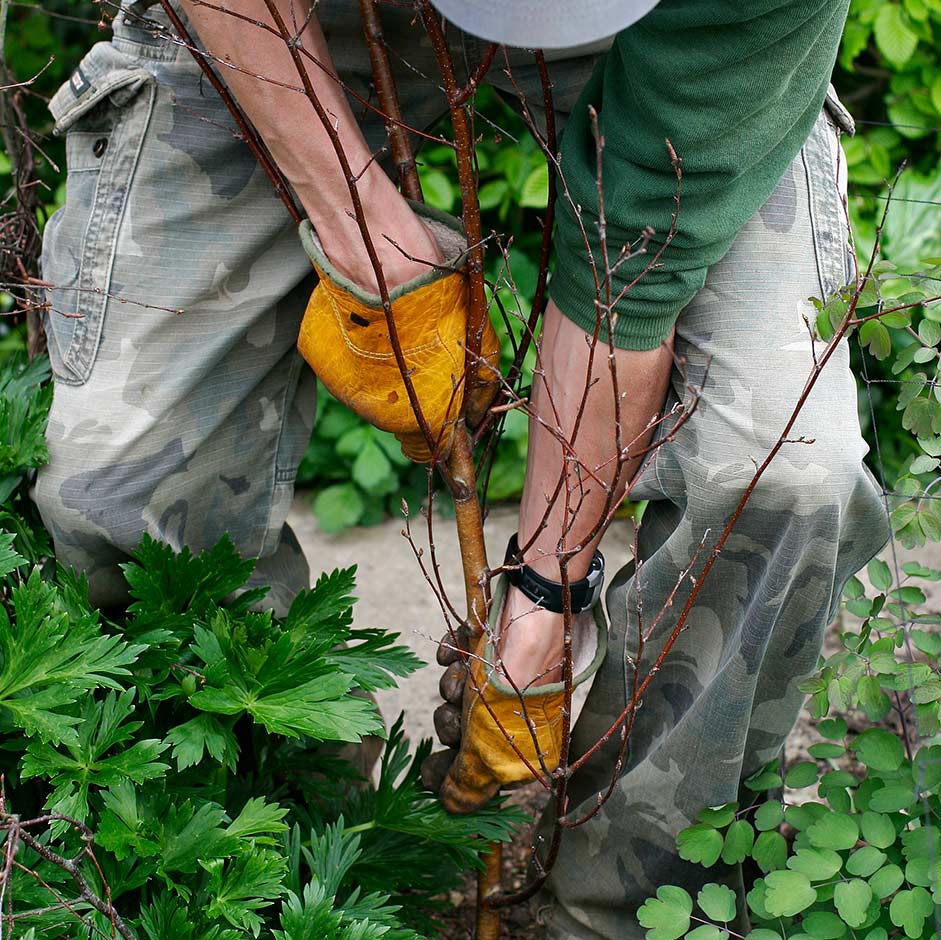Perennials: staking
Perennials in borders often put on strong lush growth that makes them vulnerable to collapse, especially after heavy rain or strong winds. Staking them early in the season will help avoid disaster. In particular; tall plants and hybrids with large flowers require additional support.

Quick facts
Timing Ideally insert supports in early spring
Difficulties Easy to moderate
Why stake perennials
Staking plants in borders is done for various reasons:
- Plants with tall brittle stems and substantial flower spikes such delphinium are easily damaged by strong winds
- Clumps of many
perennials - Even shorter perennials may droop over the edges of the border damaging the turf and will require staking
- Flowers of others, e.g. peony or dahlia, can be too heavy and may need to be staked individually to be able to appreciate the blooms
- Collapsed stems can also smother adjoining plants
Growing perennials on nutrient-rich soils or overfeeding can exacerbate the problem as it encourages soft growth that is more likely to need additional support.
When to stake perennials
Plant supports should be ideally inserted in spring, before plants have made too much growth. The plants will then grow through the support and hide it from view. Later staking is difficult as plant growth is more advanced and can easily be damaged. It may be necessary to continue tying the stems or raise the level of the used supports as the plant grows.
However, emergency staking is often necessary. Badly bent or snapped stems should be cut off cleanly. Regrowth may follow and the cut flower stems can be enjoyed in the vase. Otherwise, make-shift supports should be set up as soon as possible to minimise further damage and prevent flopped plants smothering neighbouring plants.
Where to use staking
Some points to consider when staking
- When choosing the most suitable support, you need to match it to the vigour of the plant
- Don't tie in plants too rigidly; they should be able to move in the wind
- When tying in individual stems, use a figure-of-eight technique so the string passes between the stem and the cane to prevent rubbing
- Use 3-ply soft twine for tying small plants, but 5-ply soft twine is required for larger specimens
Specific plant types
- Upright, tall, clump-forming perennials e.g. delphinium, perennial sunflower and Rudbeckia laciniata can be supported with canes or rods and twine
- Single stem ring supports can be used to support stems of plans with large single blooms such oriental poppies, foxgloves and more compact delphinium cultivars
- Bushy clump-forming perennials such as aster bellflower, Leucanthemum and phlox grow well through netting or grow-through circular grid support frames. Alternatively, use link stakes or back to back border restrains
- Top-heavy plants such as herbaceous peony and dahlias are also well-suited to grow through circular grid supports or use Y-stake supports. Spiral ring are useful to prop up such plants later on when blooming
- Pea-sticks are useful for both short front-of-the-border (e.g. penstemon, yarrow and flax) as well as taller back-border plants (e.g. Crambe cordifolia and Heliopsis)
- Using border restrains is practical way how to keep the front of the border neat and prevent flopping plants damaging the turf
Problems
Prevent physical damage to plants during the staking process by inserting supports starting early in the season when the growth commences.
Tying stems too tightly to the support can lead to stem damage.
Secure growing stems regularly or add another tier of string or netting to prevent the plants outgrowing the support and subsequent damage.
Make sure that supports for tall plants and large clumps are well anchored in the ground to prevent the support with the plants to be blown over.
Get involved
The Royal Horticultural Society is the UK’s leading gardening charity. We aim to enrich everyone’s life through plants, and make the UK a greener and more beautiful place.